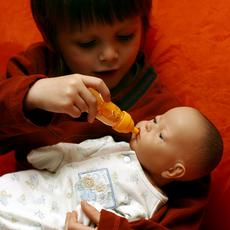Babies absorb the most bisphenol A
The hormonally active substance bisphenol A is contained in many synthetic and packaging materials. As a result, the substance can find its way into the food chain and the human organism. Just who is exposed and to what extent is shown in a new study from ETH Zurich: babies who are fed with polycarbonate bottles are especially at risk.

Bisphenol A (BPA) is the key element in polycarbonate synthetics and epoxy resins – about three million tons being produced annually all over the world. Many plastic everyday objects, medical equipment, baby bottles and food packaging are made of PC synthetic materials, whilst epoxy resins are used to coat food and drink cans and seal drinking water pipelines. Apart from via air, water and dental fillings, BPA therefore also finds its way into the organism as a result of the food coming into contact with the packaging materials or plastic containers.
Harmful even in small doses
BPA is a hormonally active substance that acts like the natural hormone estrogen and as an anti-androgen. Even small amounts of the substance can thus affect sexual development, especially for male fetuses and babies. Based on toxicological studies, the European Food Safety Authority has established a limit for the acceptable daily intake of BPA: currently 50 micrograms per kilogram of body weight. “However, the limit doesn’t include the studies on the hormonal impact of bisphenol A, which are often difficult to interpret”, says Natalie von Götz, a scientist from the Institute of Chemistry and Bioengineering.
Von Götz is the first author of a recent publication, in which various exposure studies on BPA were linked to exposure analyses. The aim was to calculate representative average values for the daily dose of BPA per kilogram of body weight for nine age groups in Switzerland, Germany and Austria. The research team from Konrad Hungerbühler’s Safety and Environmental Technology Group began by determining the individual doses that are absorbed by a particular product. This involved measuring the concentration of BPA in various foods and other relevant sources. This was multiplied by the amount absorbed by the person, which the researchers worked out from previous nutrition studies. Finally, the product was divided by the consumer’s body weight. The authors then totted up the individual doses of the 17 sources examined to obtain the average daily intake for the respective age groups.
Bottle-fed babies especially vulnerable
The study revealed that babies and infants absorb the most BPA. Babies fed using PC bottles are the worst affected, on average taking in 0.8 micrograms of BPA per kilogram of body weight via bottles. This amount is well below the statutory minimum. “But the latest studies on rats have shown that even low doses can have a harmful impact on the development of the animals”, says von Götz. The exposure declines with age, although the study also shows that it depends on the kind of diet or lifestyle: people who live on a lot of canned food, warm up their meals in PC containers in the microwave or have just had a new epoxy resin-based filling are exposed to a comparatively higher dosage of BPA. The difference with the latest studies is that they were the first to examine how much the single sources contribute to the total exposure in relation to each other, stresses von Götz. However, the study also revealed where there is still a need for research. For instance, BPA is found in canned food in different amounts. Whether this is due to the type of can or the processing remains unclear. Von Götz thus calls for the industry to share its knowledge and for more research to be carried out on the subject. After all, according to the scientist we need to reduce the amount of the substance released into food. However, the synthetic materials cannot be dispensed with altogether as they also carry considerable advantages, the coating of the cans protecting the cans as well as the food from corrosion, for example.
For von Götz, an important aspect is that nutrition studies should not only pay attention to what people eat, but also how the food is packed. More research might be necessary on the chain of custody as it is often unclear as to how substances like BPA ultimately get into the food.
Bisphenol: experts disagree on harmfulness
Like the phthalates (see ETH Life article from 17.09.2009), Bisphenol A is an essential component in many synthetic materials. The fact that there is still a considerable need for research on these chemicals not only shows that the way in which they are absorbed is often unknown, but also that some scientists warn against such substances whilst others do not perceive any adverse effects for the human organism. The film “Plastic Planet” by Werner Boote due to open soon in Swiss cinemas examines the effects of plastic and the omnipresence of synthetic material.
References
Von Götz N et al.: Bisphenol A: How the Most Relevant Exposure Sources Contribute to Total Consumer Exposure. Risk Analysis (2010), 30, 473-487, DOI: 10.1111/j.1539-6924.2009.01345.x







READER COMMENTS